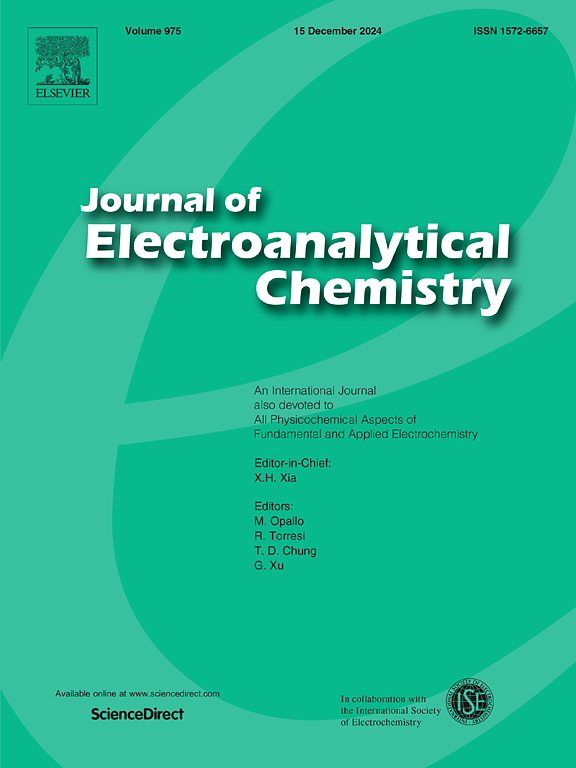通过调制几何构型加速铜配合物介导的电催化水氧化
IF 4.1
3区 化学
Q1 CHEMISTRY, ANALYTICAL
引用次数: 0
摘要
开发高效的水氧化催化剂是一项具有挑战性的工作。在此,我们证明了通过调节吡啶胺配体中的烷基链长度来破坏单核铜配合物的方锥体几何结构,从而显著调节水氧化催化活性。在中性条件下,研究了两种具有同源吡啶胺配体的铜配合物对水氧化的电催化性能。表征表明,偶氮烷基主链长度的轻微增加可以调节金属中心的几何形状,这可以通过增加几何参数来证明。这表明了一种微妙但可预测的几何变化趋势,从近乎完美的正方形金字塔到三角形双金字塔。电化学测量表明,五配位配合物具有更接近三角双锥体的几何形状,具有更高的催化活性和更低的电化学水氧化过电位。集体实验和理论计算表明,烷基链结构显著影响铜配合物的内在氧化还原性能和电催化水氧化活性。这是通过支持水对Cu(II)中心的亲核攻击,并通过创建非标准的方形金字塔几何形状促进随后的质子耦合电子转移过程来实现的。本文章由计算机程序翻译,如有差异,请以英文原文为准。

Accelerating electrocatalytic water oxidation mediated by Cu complexes via modulation of geometry configuration
The development of robust and efficient catalysts for water oxidation is challenging. Herein, we demonstrate the significant regulation of water oxidation catalytic activity in mononuclear Cu complexes by disrupting their square pyramidal geometry through modulation of the alkyl chain length in pyridine-amine ligands. The electrocatalytic properties of two Cu complexes with homologous pyridine-amine ligands toward water oxidation under neutral conditions were investigated. Characterizations indicate that a slight increase in the length of the azaalkyl backbone of the ligand modulates the geometry of the metal center, as evidenced by increasing geometric parameters. This suggests a subtle but predictable trend in the geometry change from near-perfect square pyramidal to trigonal bipyramidal. Electrochemical measurements reveal that the pentacoordinated complex with a geometry closer to trigonal bipyramidal exhibits significantly higher catalytic activity and much lower overpotential for electrochemical water oxidation. Collective experiments and theoretical calculations elucidate that the alkyl chain structure significantly influences the intrinsic redox properties and electrocatalytic water oxidation activity of Cu complexes. This is achieved by favoring water nucleophilic attack on the Cu(II) center and facilitating the subsequent proton-coupled electron transfer process through the creation of a non-standard square pyramidal geometry.
求助全文
通过发布文献求助,成功后即可免费获取论文全文。
去求助
来源期刊
CiteScore
7.80
自引率
6.70%
发文量
912
审稿时长
2.4 months
期刊介绍:
The Journal of Electroanalytical Chemistry is the foremost international journal devoted to the interdisciplinary subject of electrochemistry in all its aspects, theoretical as well as applied.
Electrochemistry is a wide ranging area that is in a state of continuous evolution. Rather than compiling a long list of topics covered by the Journal, the editors would like to draw particular attention to the key issues of novelty, topicality and quality. Papers should present new and interesting electrochemical science in a way that is accessible to the reader. The presentation and discussion should be at a level that is consistent with the international status of the Journal. Reports describing the application of well-established techniques to problems that are essentially technical will not be accepted. Similarly, papers that report observations but fail to provide adequate interpretation will be rejected by the Editors. Papers dealing with technical electrochemistry should be submitted to other specialist journals unless the authors can show that their work provides substantially new insights into electrochemical processes.

 求助内容:
求助内容: 应助结果提醒方式:
应助结果提醒方式:


